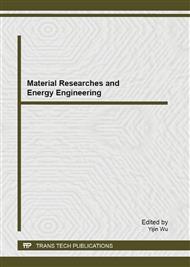[1]
H. Ohno, A. Shen, F. Matsukura, A. Oiwa, A. Endo, S. Katsumoto, and Y. Iye. Appl. Phys. Lett. Vol. 69 (1996), p.363.
DOI: 10.1063/1.118061
Google Scholar
[2]
K. Ueda, H. Tabata, and T. Kawai. Appl. Phys. Lett. Vol. 79 (2001), p.988.
Google Scholar
[3]
S. A. Chambers, S. Thevuthasan, R. F. C. Farrow, R. F. Marks, and J. U. Appl. Phys. Lett. Vol. 79 (2001), p.3467.
Google Scholar
[4]
H. Li, H.Q. Bao, B. Song, W.J. Wang, X.L. Chen, Solid State Commun. Vol. 148 (2008), p.406.
Google Scholar
[5]
X.H. Ji, S.P. Lau, S.F. Yu, H.Y. Yang, T.S. Herng, A. Sedhain, J.Y. Lin, H.X. Jiang, K.S. Teng, and J.S. Chen, Appl. Phys. Lett. Vol. 90 (2007), p.193118.
DOI: 10.1063/1.2738370
Google Scholar
[6]
M. K. Li, C.B. Li, C.S. Liu, X.J. Fan, D.J. Fu, Y. Shon, and T.W. Kang, Chin. Phys. Lett. Vol. 21 (2004), p.393.
Google Scholar
[7]
X. H. Ji, S.P. Lau, S.F. Yu, H.Y. Yang, T.S. Herng, and J.S. Chen, Nanotechnology, Vol. 18 (2007), p.105601.
Google Scholar
[8]
E. Tirosh and G. Markovich, Adv. Mater. Vol. 19 (2007), p.2608.
Google Scholar
[9]
N. H. Hong, N. Poirot, and J. Sakai, Phys. Rev. B. Vol. 77 (2008), p.033205.
Google Scholar
[10]
D. Pratibha, X. Yu, and P. H. Zhang. Phys. Rev. Lett. Vol. 100 (2008), p.117204.
Google Scholar
[11]
W. W. Lei, D. Liu, P. W. Zhu, X. H. Chen, Q. Zhao, G. H. Wen, Q. L. Cui, and G. T. Zou, J. Phys. Chem. C. Vol. 114 (2010), p.15574.
Google Scholar
[12]
W. W. Lei, D. Liu, P. W. Zhu, X. H. Chen, Q. Zhao, G. H. Wen, Q. L. Cui, and G. T. Zou. Appl. Phys. Lett. Vol. 95 (2009), p.162501.
Google Scholar
[13]
Jussi-matti maki. Influence of vacancy defects on the optical properties of natural diamond and aluminium nitride. Aalto university publication series. School of science department of applied physics. Doctoral dissertations. (2012).
Google Scholar
[14]
C. Stampfl and C. Van de Walle, Phys. Rev. B Vol. 65 (2002), p.155212.
Google Scholar
[15]
Y. Zhang, W. Liu, and H.B. Niu, Phys. Rev. B Vol. 77 (2008), p.035201.
Google Scholar
[16]
RobertA. Youngman. and Jonathan H. Harris. J Am Cerom Soc Vol. 73 (1990), p.3238.
Google Scholar
[17]
Pratibha. Dev, Yu. Xue, and Peihong. Zhan, Phys. Rev. Lett. Vol. 100 (2008), p.117204.
Google Scholar
[18]
J.P. Perdew and Y. Wang, Phys. Rev. B. Vol. 45 (1992), p.13244.
Google Scholar


